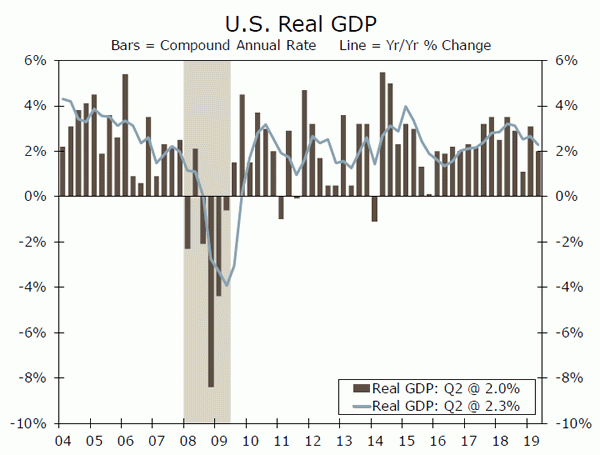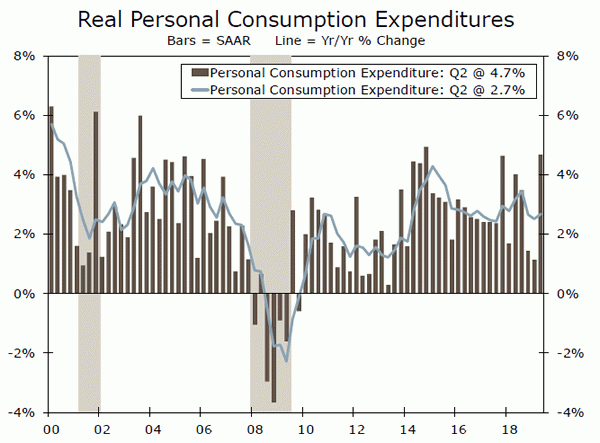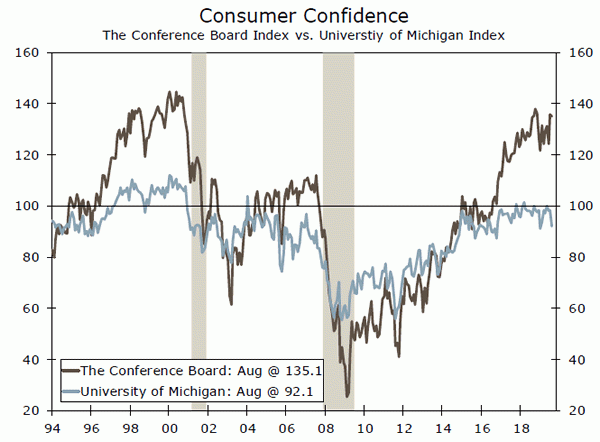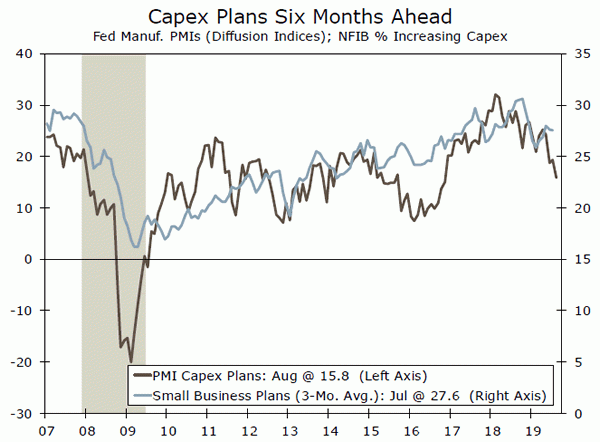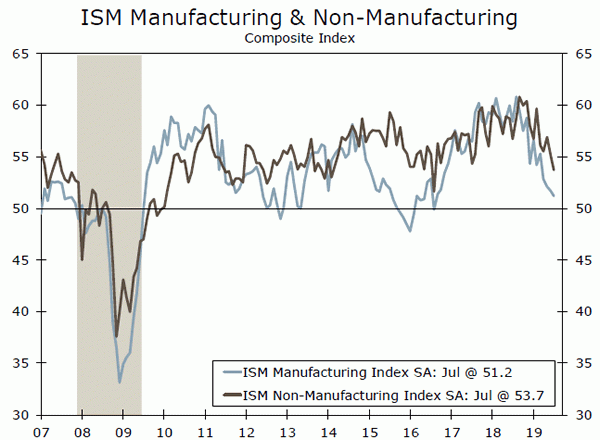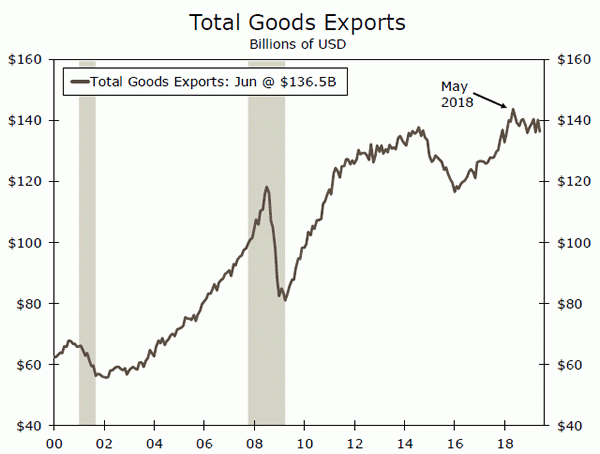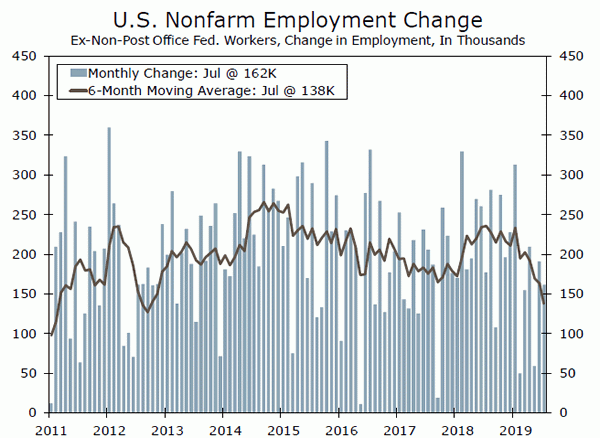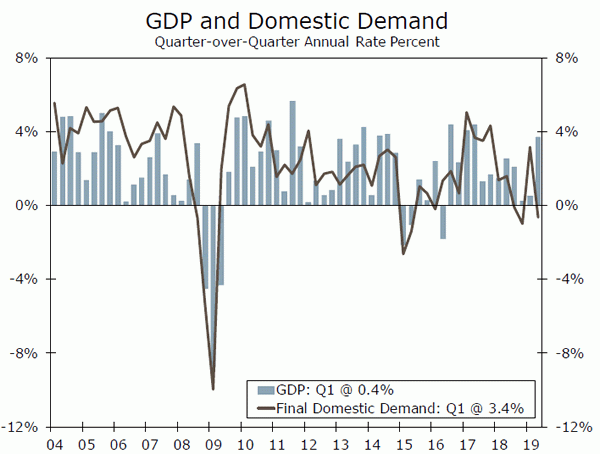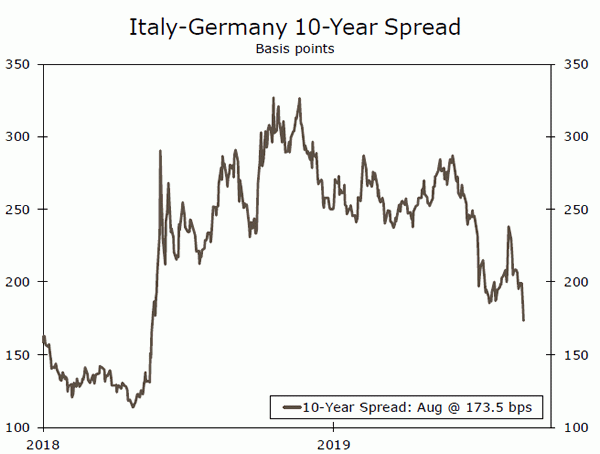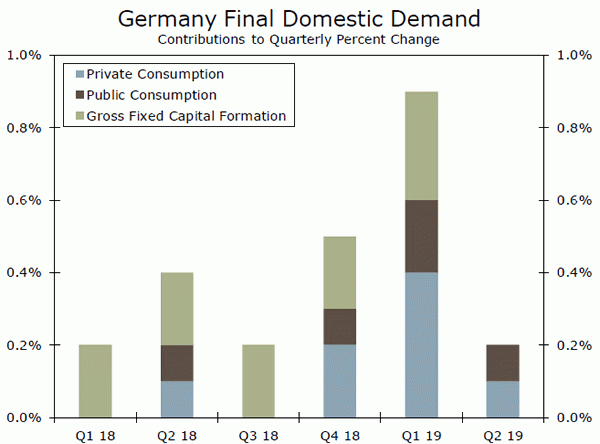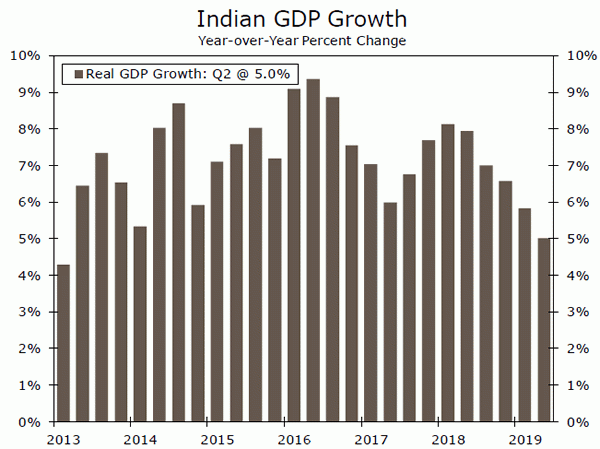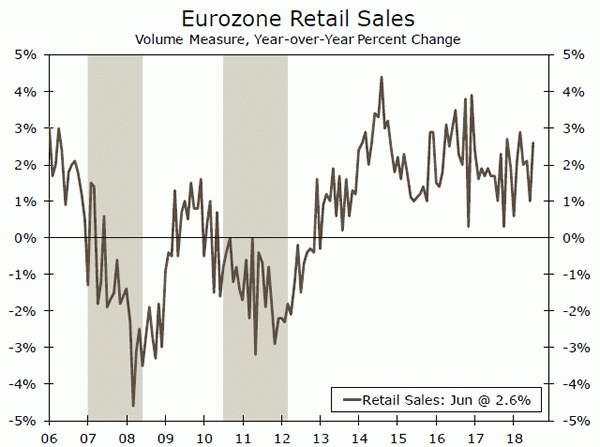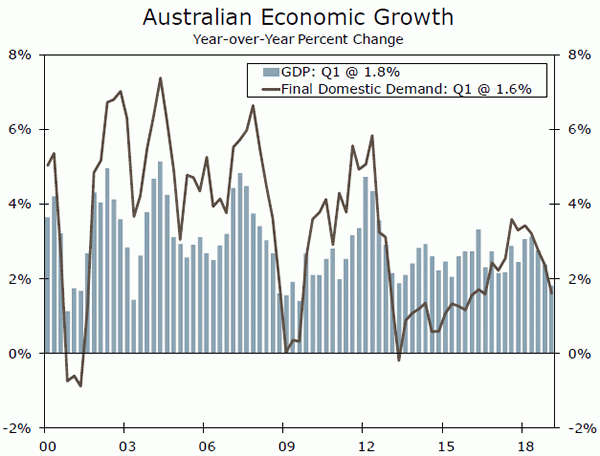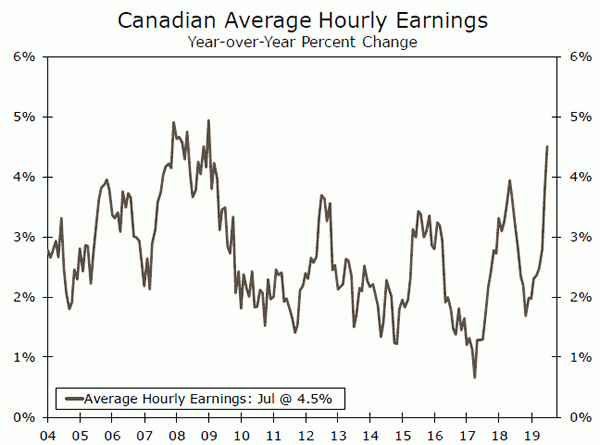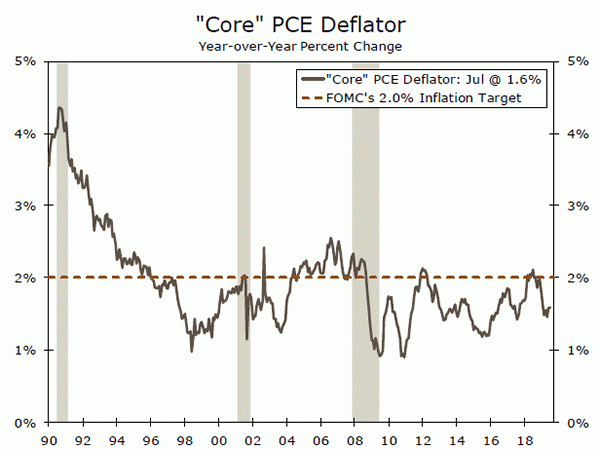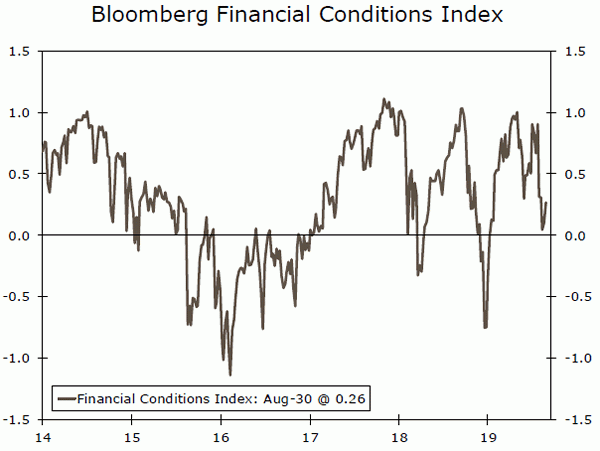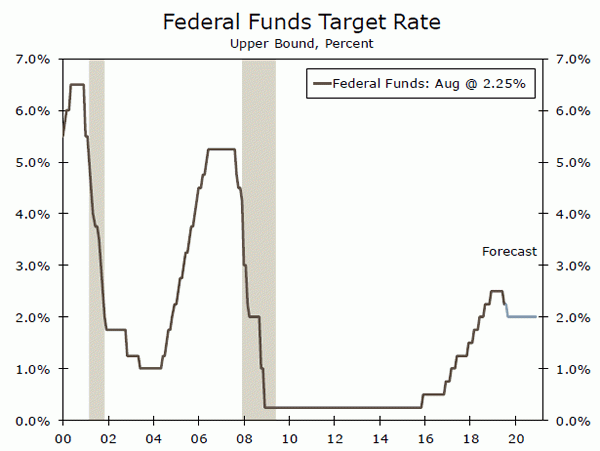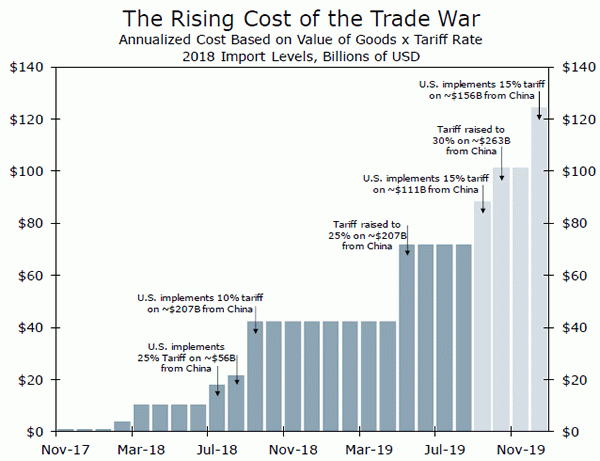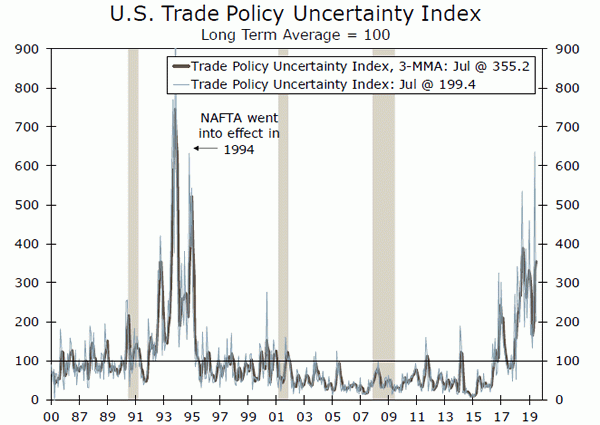U.S. Review
Consumers Keeping the U.S. Economy Afloat
- Revised data show the U.S. economy grew at a 2.0% annualized pace in the second quarter, a tenth lower than the initial estimate. Data thus far for Q3 suggest consumer spending should remain elevated, but the manufacturing sector continues to struggle in the face of ongoing trade uncertainty.
- The Fed has been questioned about its independence in recent weeks, and we direct interested readers to our Interest Rate Watch section for more on that topic. We suspect the Fed is monitoring the incoming data closely, and with the manufacturing sector under pressure and inflation below target, we expect the FOMC to cut rates 25 bps in September.
Consumers Keeping the U.S. Economy Afloat
The second estimate of Q2 GDP showed the economy grew at a 2.0% annualized pace, which was only a tenth lower than the initial estimate. We already knew from the first release that the consumer carried the weight in the second quarter. But revised data show personal consumption expenditures rose an even stronger 4.7% (4.3% previously), adding 3.1 percentage points to headline growth. As shown in the top chart, that is the fastest quarterly pace in nearly five years, and significantly above of the 2.5% average quarterly figure we have seen this expansion.
Monthly consumption data suggest spending is off to a solid start in the third quarter. Retailers saw strong sales in July, consistent with this morning’s personal consumption data, which showed a 0.6% increase in spending last month. Johnson Redbook sales data, which track same-store sales, also suggest sales remained strong in August. Not only is the spending data coming in strong, measures of consumers’ confidence remained surprisingly elevated this month, despite financial market instability and constant headlines about the trade war. Consumer fundamentals suggest spending should remain solid in H2-2019, though a pace north of 4% is unlikely to be sustained.
Outside of the consumer, other areas of the economy struggled in the second quarter. Residential construction declined for the sixth straight quarter, and in the face of trade uncertainty, business fixed investment declined for the first time since 2016. Equipment spending managed to eke out a modest 0.7% gain, but prospects for Q3 spending are quickly falling. Nondefense capital goods shipments, which feed into equipment spending, retreated 3.0% in July, after being revised lower to only a 0.9% gain in June. Amplified trade rhetoric over the past month is unlikely to help the capex picture anytime soon. On Saturday, the first tranche of the most-recent escalation in the U.S.-China trade war will go into effect—a 15% tariff on approximately $107 billion of imports from China. Then, on December 15, approximately $156 billion more imports will be exposed. Even with these tariffs set to go into effect, the trade environment remains largely uncertain. Just last week the Trump administration called for a 5% increase on all tariffs.
Consumers will be more exposed with these new rounds, but unless confidence is meaningfully hit, we still expect the impact on spending to be minimal. The manufacturing sector, however, is weakening under trade uncertainty. Industrial production declined in July, and manufacturing production is in a trend decline thus far in 2019. Further, the PMI data for August were mixed, with two regions reporting a decline in activity and the Markit Manufacturing PMI slipping into negative territory for the first time since September 2009. Meanwhile, capital spending plans at manufacturers continue to edge lower as global growth slows further and trade uncertainty lingers.
We expect the FOMC is closely monitoring the incoming data. The Fed’s preferred measure of inflation, the PCE deflator, remained unchanged at 1.6% in July, which gives the Fed the green light for further easing. We expect the Fed to cut rates another 25 bps in a few weeks at its September meeting.
U.S. Outlook
ISM Surveys • Tuesday & Thursday
Deteriorating survey evidence since mid-2018 has made clear that economic growth is set to slow. The ISM manufacturing survey fell first and further, as the factory sector has been hit harder by slowing global growth and intensifying trade war headwinds. It remains just barely in expansion territory, and we expect it to slow further to 50.9 in August. Yet the United States is still faring better than other more export-oriented countries, where manufacturing PMIs are in outright contraction territory. Moreover, the non-manufacturing index, which measures sentiment across the much larger services sector, has yet to decelerate as much. Last month it did fall to its lowest level in almost three years, but with the U.S. consumer remaining strong—consumer confidence was unfazed this week and GDP revisions indicated real PCE rose at a whopping 4.7% pace in Q2—the more domestically oriented service sector should continue to weather the storm, with the non-man index rising to 54.0.
Previous: 51.2 & 53.7 Wells Fargo: 50.9 & 54.0 Consensus: 51.2 (Man.) & 54.0 (Non-Man.)
Trade Balance • Wednesday
The advance goods trade balance (released Thursday) narrowed, as exports rose 0.7% and imports fell 0.4%. Capital goods imports are now down 4.5% year-over-year, consistent with the decline in manufacturing sentiment and plans for further investment. We expect the overall trade balance, which includes the surplus that the United States runs in services, will also narrow in July, to -$53.4 billion.
The trade balance figures may be particularly volatile in coming months as businesses scramble to react to an ever-fluid tariff timeline, but overall trade is slowing. Exports peaked in May 2018, and the ISM new export orders subcomponent sitting in contraction territory at 48.1 portends further weakness. GDP revisions this week indicated that net exports dragged a larger than first reported 0.7 percentage points from growth in Q2. We expect trade to make a very modest 0.1 percentage point contribution to headline growth in Q3.
Previous: -$55.2B Wells Fargo: -$53.4B Consensus: -$54.3B
Employment • Friday
Employment growth should continue to hold up in August, giving the Fed no reason to adjust its July meeting characterization of the labor market as “strong”. Initial claims this week rose a scant 4K, and show no signs of breaking meaningfully higher. The six-month moving average of nonfarm gains has certainly come down, especially relative to last year’s impressive pace, but continued gradual labor market tightening has kept income and spending rising. We expect a 150K gain in August, which should keep the unemployment rate steady at 3.7%. Average hourly earnings should rise 0.2%—nothing to suggest a material increase in inflation in the pipeline.
The BLS last week announced its preliminary annual benchmark revisions to the nonfarm employment statistics, indicating that employment through March 2019 was 501,000 jobs lower than previously thought. The revision will not officially hit until the January 2020 employment report.
Previous: 164,000 Wells Fargo: 150,000 Consensus: 168,000
Global Review
European Politics Continue to Astound
- It was quite a week for Europe. U.K. Prime Minister Boris Johnson moved to prevent Parliament from sitting for nearly a month between mid-September and mid-October, giving lawmakers less time to plot to stop a no-deal Brexit. Meanwhile, opposition parties in Italy managed to form an unexpected coalition government, helping avoid early elections.
- GDP reports from key countries, including Brazil, Canada and India, were mixed. A strong headline print in Canada belied soft underlying details, while India’s growth slowed sharply and Brazil’s figures surprised to the upside.
European Politics Continue to Astound
There was quite a bit of focus on Brexit this week after a surprise move from U.K. Prime Minister Boris Johnson to “prorogue” U.K. Parliament, or prevent it from sitting, from mid-September through October 14. Parliament had already been scheduled to be on recess for much of that time due to various party conferences, but PM Johnson’s move further reduces the amount of time lawmakers are scheduled to be in session between now and the October 31 Brexit deadline. The move raises the chances of a nodeal Brexit (now 40%, in our view), as it gives less time for members of Parliament (MPs) to maneuver to block a no-deal Brexit. It also means next week is likely to be a contentious one as PM Johnson faces off with MPs opposed to a no-deal Brexit. Labour leader Jeremy Corbyn has threatened to put forth a motion of no-confidence in Johnson’s government, and may do so next week. That said, Johnson’s move to prorogue Parliament also raises the chance of the U.K. leaving the E.U. with a deal (now 45%, in our view). Indeed, with Parliament less able to block a no-deal Brexit, the E.U. may be more compelled to offer concessions to the U.K. on the Irish border backstop as a means of averting a no-deal exit.
Sticking with the European political theme, Italian opposition parties Five Star and the Democrats formed a government, averting a snap election. Italian sovereign bonds rallied on hopes that the new coalition will put forth a relatively market-friendly budget for 2020, averting another showdown with the European Commission. That said, we have doubts over the ability of the Five Star-Democrat coalition to govern over the longer term given the vast differences in policy views and razor thin parliamentary majority. Thus, fears of another snap election may resurface again in the not-too-distant future. The data this week from Europe followed a similar theme to the politics—mixed. In August, Germany’s IFO index fell further to 94.3, the lowest since 2012, while unemployment rose 4,000. Meanwhile, Eurozone CPI inflation firmed only slightly to 1%, while core CPI inflation slowed more than expected to 0.9% year-over-year. On a more positive note, we learned that the drop in German GDP in Q2 was mostly driven by a negative contribution from net exports, as final domestic demand actually rose 0.3% (not annualized) during the quarter after a strong 0.9% increase in Q1. While Germany’s economy is especially weak at present, these domestic demand figures offer an interesting counterpoint to the seemingly constant doom-and-gloom around the country’s economic prospects.
Last but not least, Q2 GDP releases from three major economies all told very different stories. Real GDP in Canada rose 3.7% on a sequential annualized basis, topping expectations, but final domestic demand fell 0.7%. India’s real GDP growth slowed to just 5.0% year-over-year, the weakest since 2013 and down from more than 8% in Q1-2018, driven by broad weakness in domestic demand. On a more positive note, Brazil’s figures were better than expected, as real GDP rose 0.4% (not annualized) on a sequential basis, while annual growth picked up slightly to 1%.
Global Outlook
Eurozone Retail Sales • Wednesday
Despite the seemingly constant barrage of negative data out of the Eurozone over the past several months, one source of relative stability and resilience has been the Eurozone consumer. Retail sales have actually accelerated, albeit modestly, over the past few months even as the industrial and export picture has worsened. The resilience in consumer spending, far and away the largest sector of the Eurozone economy, is a somewhat relieving sign.
The question, in our view, is whether consumers can continue to buoy the Eurozone economy as the manufacturing malaise drags on. If businesses continue to feel the pinch from weaker overseas demand, it may start to affect hiring and wage decisions. Employment growth has steadily been slowing over the past few quarters, but for now real wage growth appears solid enough to keep the consumer afloat.
Previous: 1.1% Consensus: -0.6% (Month-over-Month)
Australia GDP • Wednesday
Australia’s miraculous stretch of nearly 30 years without a recession has not yet technically ended, but the performance of Australia’s economy in recent quarters has been anything but miraculous. Real GDP growth has slowed materially since last year, and underlying domestic demand tells a similar story of weakening momentum. Investment has been a key source of weakness for the Australian economy, including a deflating property bubble and softer demand from China.
Consumer spending has also weakened, however, a sign that the weakness in Australia’s economy is fairly widespread. With inflation also fairly subdued, the Reserve Bank of Australia (RBA) has already cut rates 50 bps this year to 1.00%, and we see a moderate chance of another rate cut by year-end. Next week’s GDP release could offer insight into the degree of urgency for further RBA easing.
Previous: 0.4% Consensus: 0.5% (Quarter-over-Quarter)
Canada Employment • Friday
July was a challenging month for the Canadian labor market. Net employment fell by 24,200, the largest drop in nearly a year, driven by declines in both part-time and full-time jobs, while the jobless rate ticked higher to 5.7% even as participation fell. That said, wage growth strengthened much more than expected to 4.5% year-overyear, the quickest pace in roughly a decade.
The figures paint a mixed picture for the Bank of Canada (BoC), which has signaled steady policy for now even as many other major central banks have signaled or delivered rate hikes in recent months. We suspect the BoC will be on hold for the foreseeable future, and do not see enough signs of weakness to justify a rate cut at this point. The employment and wage figures will be among the most important to watch in the context of future BoC policy moves, although oil prices and the path of the U.S. economy also remain relevant.
Previous: -24,200
Point of View
Interest Rate Watch
Between a Rock and Hard Place
The Federal Reserve’s operational independence has been in the spotlight again over the past week. The Fed continues to face a barrage of criticism from President Trump, while earlier this week, former New York Fed President Bill Dudley wrote a controversial op-ed about how the Fed may best combat the trade war.
We are not here to opine on either position, but like it or not, the Fed is increasingly entwined in the trade war. Skeptics question how much lower interest rates can benefit the economy at this juncture. After all, the cost of credit is still historically low, and lower interest rates do not solve the underlying issue of growing trade uncertainty (see Topic of the Week for more on this.) Cutting interest rates risks the FOMC appearing like it is caving to political pressure and potentially fueling financial imbalances down the road.
Our view is that the Federal Reserve takes its dual mandate in earnest. Officials aim to best achieve maximum employment and price stability in whatever environment they are dealt, neither championing nor opposing government policy along the way. To that end, core PCE inflation remains stubbornly below 2% (top chart). Historically low inflation expectations have heightened concerns about a sustained return to 2%.
Adding unease to the inflation outlook is that the FOMC sees growth slowing more generally. Uncertainty around the U.S. and global outlook is elevated, not just from trade but also from the threat of a no-deal Brexit and unrest in Hong Kong. By Powell’s own admission, monetary policy cannot provide a “settled rulebook for international trade.” However, the Fed can offset some of the negative effects of current trade policy by helping to ease financial conditions (middle chart). Less expensive credit may mitigate the effects of heightened uncertainty by benefiting consumers and firms more exposed to trade, and bring the Fed closer to its dual mandate.
We therefore look for the Fed to ease policy further at its September meeting with a 25 bps cut (bottom chart), although the decision is unlikely to be unanimous.
Credit Market Insights
Refinancing Streak Comes to an End
Mortgage applications declined 6% last week, as applications for new purchases continued to disappoint and applications for refinancing ended a month’s long streak of growth. This most recent decline in refinancing applications comes alongside a slight increase in the average 30-year fixedrate to 3.94% from 3.90%, according to the Mortgage Bankers Association’s report. It is important not to read too much into one report given the week-to-week volatility in the survey. Increases over the past month put the refinancing index up 167% over this period last year, even after this most recent decline. This growth has largely been attributed to a notable decline in interest rates over this period, but it is worth asking how much lower rates will affect consumers given the current composition of household balance sheets.
In a report last month, we highlighted that more household debt is in fixed rate structures, compared to prior cycles, suggesting that consumers may be less immediately impacted by lower interest rates. While there is the opportunity to refinance these fixed-rate contracts, households do not appear to as burdened by debt service payments compared to prior cycles. The household financial obligation ratio, which tracks the ability of households to service their debt, is historically low. Of course this is not true for everyone, but broadly speaking it does not appear that any move lower in interest rates will dramatically change the outlook for consumers.
Topic of the Week
Counting Throes: August & Everything After
What represents a bigger escalation: a 10% tariff on $207 billion of goods? Or a 15% tariff on $156 billion of goods that does not go into effect until December? And what happens when you ratchet up the tariff rate on one but not the other?
Keeping up with the latest developments in the ongoing trade war requires more than just a timeline or a simple running tally of the total dollar amount of goods affected. A high tariff rate on a small subset of goods, for example, could have a greater cost than a lower tariff rate on a much larger dollar amount of goods.
The top chart is our latest tool to help you visualize the increasing costs of the trade war. The concept here is to apply the stated tariff rate to the dollar amount of the impacted goods at their 2018 import level. This is not a perfect indication as of course supply chains will tend to shift as U.S. importers find alternate foreign sources or domestic providers for various categories. But it offers a better understanding than a simple summing of the affected goods would offer on its own. This is especially true when you consider that there are certainly some goods where a viable alternative is not readily available.
The barely visible bars that occur prior to March 2018 reflect that the effective cost of the early skirmishes, like the softwood lumber tariffs in late 2017, the solar panels and washing machines at the start of 2018 and later the steel and aluminum tariffs, are quite small. The more recent and more significant escalations targeting China are highlighted with callouts on the graph. The takeaway from this exercise is that the past six months have seen a significant escalation in the trade war.
Regardless how you measure it, trade uncertainty is rising and there are growing signs of stress in manufacturing. Plans for capital expenditures as reported by the various regional Fed surveys have signaled a slowing in investment, and the Markit manufacturing PMI slipped into contraction territory for the first time since the recession year of 2009.




